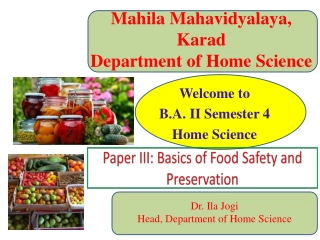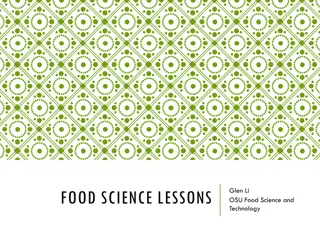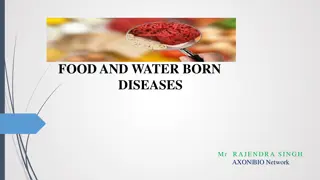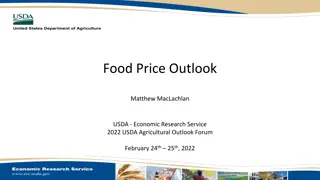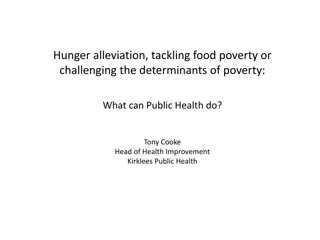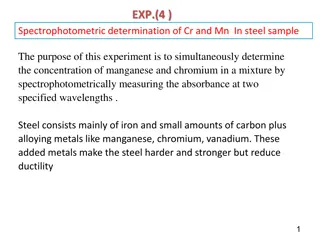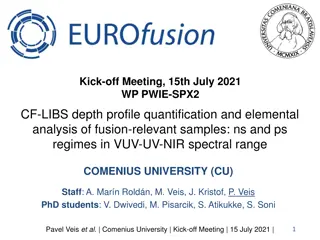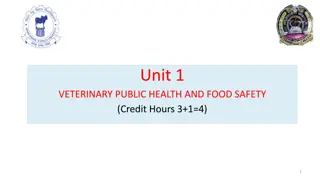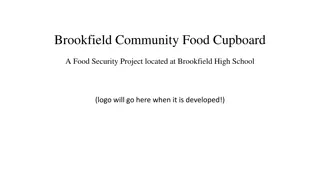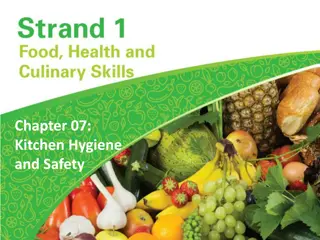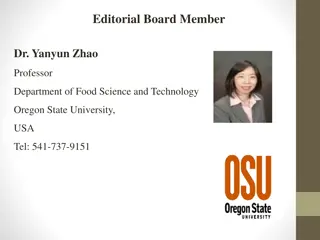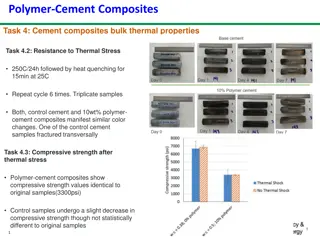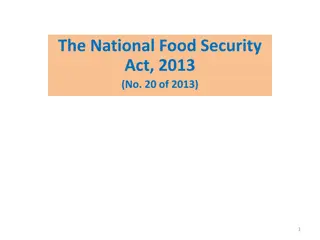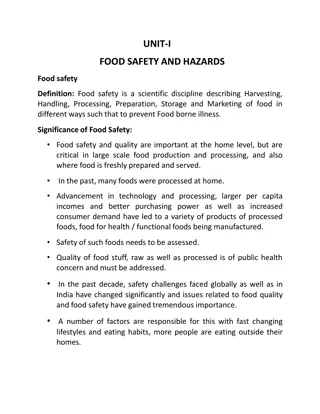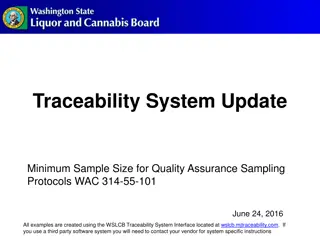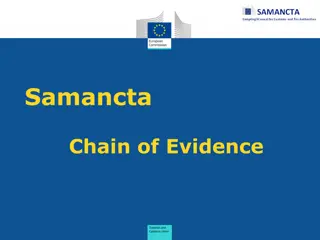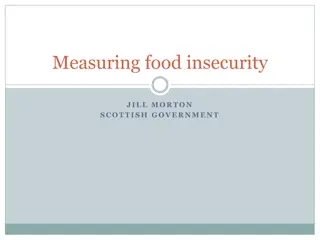BSc Food Science & Human Nutrition Programme Overview
This BSc Food Science & Human Nutrition programme at Maynooth University offers a comprehensive understanding of nutrition, biology, and chemistry as applied to food. With a focus on ingredients, production, products, and nutrition, students explore various aspects of food science including food saf
3 views • 12 slides
Comprehensive Guide to Food Safety and Preservation in Home Science
Explore the world of food safety and preservation through this detailed course in Home Science at Mahila Mahavidyalaya, Karad. The course covers topics like basics of food safety, principles of food preservation, methods of food preservation, and practical sessions on preparing various food items. G
1 views • 6 slides
Understanding Food Safety in Hospitality and Catering
Learners will explore food-related causes of ill health in hospitality and catering, including microbes and bacteria that can lead to food poisoning. Factors such as warmth, time, food supply, and moisture create ideal conditions for harmful bacteria to thrive and cause illness. This topic covers fo
5 views • 75 slides
Transforming School Food Education for Health and Wellbeing
The Food Education Roadmap aims to prioritize health and wellbeing through food for students, promoting a culture of healthy eating, wellness, and lifelong habits. It emphasizes access to healthy food, nutrition education, experiential learning, and community involvement. The initiative requires col
2 views • 12 slides
The Slow Food Movement: A Revolution in Food Culture
The Slow Food Movement, initiated by Carlo Petrini in 1986, challenges the fast food industry and advocates for mindful consumption. Petrini's vision promotes awareness of food sourcing, support for sustainable practices, fair compensation for producers, and the enjoyment of nutritious, flavorsome f
1 views • 17 slides
Role of Microorganisms in Food and Industry
Microorganisms play a crucial role in the food and industrial sectors, both benefiting and causing harm. They are involved in processes such as organic compound transformation, fermentation, and food production. While beneficial microorganisms contribute to the creation of various useful food produc
5 views • 44 slides
How are plant essential oils valuable as functional ingredients
Food Research Lab is one of the leading food industry consultants and offers various food production services. We provide food production and food manufacturing consultancy services to food, beverage and nutraceutical companies. Primary food production involves everything from food procurement, inve
8 views • 12 slides
Takeout Food In Orlando
Takeout food in Orlando. It's known for being live\u00adly, teeming with zest and a host of food on the\u00ad go to cater to any palate. Looking for high-end tre\u00adats, food from around the globe, or just some good old comfort food? Orlando's got you cove\u00adred. From real-deal Me\u00adxican ta
1 views • 4 slides
Exploring Food Science and Technology Learning Opportunities
Dive into the world of food science and technology with engaging lessons covering topics such as food safety, nutrition, and sensory properties. Discover the importance of teaching food science, explore themed lessons suitable for remote delivery, and understand the relevance of food science schemes
0 views • 13 slides
Systematic Analysis of Real Samples in Analytical Chemistry
This analysis covers the systematic process involved in analyzing real samples, including sampling, sample preservation, and sample preparation. It discusses the importance of accurate sampling in obtaining information about various substances, such as solids, liquids, gases, and biological material
0 views • 54 slides
Understanding Food and Water-Borne Diseases: Causes and Classification
Food and water-borne diseases, caused by contaminated food or water, lead to acute illnesses. These diseases are classified into food-borne infections and food-borne intoxications. Food-borne infections, triggered by pathogenic microorganisms, can be fungal, bacterial, viral, or parasitic, with long
3 views • 57 slides
Overview of Food Price Trends and Consumer Expenditures in the US
The presentation highlights the consumer spending on food, food price trends over time, 2021 food prices, and forecasts for 2022 in a historical context. It emphasizes that U.S. consumers spent 12% of their expenditures on food in 2020, aligning with historical averages. Food price inflation remaine
0 views • 21 slides
Addressing Food Poverty and Hunger: Public Health Initiatives
Public Health plays a crucial role in combating food poverty by addressing factors such as lack of access to healthy food, inadequate cooking skills, and economic limitations. Issues like irregular work schedules, limited nutritious food choices, and stigma associated with food insecurity further co
1 views • 13 slides
Spectrophotometric Determination of Cr and Mn in Steel Samples
This experiment aims to determine the concentrations of manganese and chromium in steel samples by converting Cr3+ and Mn2+ ions to light-absorbing forms, followed by spectrophotometric measurements at specific wavelengths. Steel samples are oxidized, dissolved, and further oxidized to form dichroma
0 views • 10 slides
Depth Profile Analysis of Fusion-Relevant Samples Using LIBS Technique
Analysis of fusion-relevant samples through Laser-Induced Breakdown Spectroscopy (LIBS) is conducted at Comenius University. The study compares picosecond (ps) and nanosecond (ns) regimes in depth profiling and quantification of tungsten-based coatings and other fusion materials. The research also i
0 views • 8 slides
Understanding Food Packaging and Labelling Requirements in NSW Education
Learn about the importance of food packaging options, including materials used and the roles they play in protecting food products. Explore the reasons for food packaging in terms of preservation, marketing, and consumer information needs. Discover the legislative requirements for food labelling in
5 views • 18 slides
Food Equipment Usage Guidelines for Safe Food Handling
Enhance your knowledge on using equipment for making food with proper safety procedures. Learn about essential points like wearing protective gear, checking hot food temperatures, food safety principles, and sanitization requirements. Understand machine settings, food temperature checks, and serving
1 views • 22 slides
Veterinary Public Health and Food Safety: Ensuring Safe Consumption
Introduction to food safety and hygiene, emphasizing the importance of controlling hazards to ensure food fitness for human consumption. Discusses the responsibilities of ensuring food safety and suitability along the food chain, as well as the general principles of food hygiene such as primary prod
1 views • 15 slides
National Food Reserve Agency (NFRA): Enhancing Food Security in Nigeria
The National Food Reserve Agency (NFRA) under the Federal Ministry of Agriculture & Water Resources plays a crucial role in addressing agricultural production, storage, and marketing challenges in Nigeria. With a vision to ensure sustainable food access for all Nigerians and become a global food pro
1 views • 30 slides
Best Practices for Food Preparation to Ensure Food Safety
This chapter highlights essential practices for prepping food to prevent cross-contamination and time-temperature abuse in a food service setting. Topics covered include safe methods for thawing food, cooking temperatures, microwave cooking, informing consumers of risks, requirements for partially c
1 views • 25 slides
Navigating Statistical Inference Challenges in Small Samples
In small samples, understanding the sampling distribution of estimators is crucial for valid inference, even when assumptions are violated. This involves careful consideration of normality assumptions, handling non-linear hypotheses, and computing standard errors for various statistics. As demonstra
0 views • 19 slides
Exploring Food Science and Technology in Modern Society
Delve into the world of food science and technology with insights on what scientists do, the importance of understanding food, definitions of food science and food technology, factors affecting food spoilage, and traditional and modern food processing technologies. Gain knowledge on testing hypothes
0 views • 22 slides
Food Safety Practices in Service Industry
This chapter focuses on the essential food safety practices in the service industry, covering topics such as time and temperature requirements for holding food, ways to prevent time-temperature abuse and cross-contamination, minimizing bare-hand contact with food, preventing staff and customers from
0 views • 26 slides
Brookfield Community Food Cupboard: Addressing Food Insecurity at Brookfield High School
Brookfield Community Food Cupboard is a project aiming to provide food security to individuals and families in the Riverside Park/Hunt Club area, including students and families served by Brookfield High School. The initiative seeks to supplement existing food security programs by offering a day's w
0 views • 11 slides
Food Safety and Preventing Food-borne Illness
This lesson focuses on the importance of food safety, addressing how clean our food is and at what points safety can be compromised. It delves into common types of microbes that contaminate foods and explores ways in which food safety can be compromised. The activity involves case studies on food sa
0 views • 11 slides
Mastering Good Food Hygiene and Storage Practices
Understanding food spoilage causes, common food-poisoning bacteria, conditions for bacterial growth, ways to prevent food contamination, safe food handling practices, HACCP concept, types of perishable foods, importance of proper food storage, packaging materials for food, and recognizing signs of f
1 views • 27 slides
Understanding Kitchen Hygiene and Food Safety
Kitchen hygiene and food safety are crucial to prevent food spoilage and food poisoning. Factors like enzymes, micro-organisms, and oxygen can lead to food spoilage, while food poisoning occurs when pathogenic bacteria multiply in consumed food. Practicing proper hygiene, storage, and preparation me
0 views • 27 slides
Dr. Yanyun Zhao - Food Science & Technology Professor at Oregon State University
Dr. Yanyun Zhao is a prominent Professor at Oregon State University specializing in food science and technology. With a strong research focus on food processing technologies and food safety, Dr. Zhao has made significant contributions to the field. Her expertise in value-added food processing, antim
0 views • 16 slides
Study on the Thermal and Chemical Properties of Polymer-Cement Composites
The study investigates the resistance of polymer-cement composites to thermal stress and chemical attacks such as acidic and high CO2 environments. Results show similar color changes in control cement and polymer-cement composites after thermal stress, with the latter maintaining compressive strengt
0 views • 5 slides
National Food Security Act, 2013 Overview
The National Food Security Act, 2013 (NFSA) aims to ensure food and nutritional security for all by providing access to adequate quality food at affordable prices. It includes provisions for hot cooked meals, food security allowance, social audit, nutritional support for children, and various monito
0 views • 15 slides
Importance of Food Safety in Modern Food Production
Food safety is crucial in modern food production to prevent foodborne illnesses. With advancements in technology and increased demand for processed foods, the need to ensure the safety and quality of food has become paramount. Factors affecting food safety include poor hygiene practices, contaminate
0 views • 30 slides
Understanding Food Justice and Insecurity: A Comprehensive Overview
Food Justice Primer provides insightful definitions and discussions on key concepts such as food justice, food insecurity, food sovereignty, and food deserts. It highlights the need for equitable sharing of benefits and risks in the food system, aiming to transform current disparities and inequities
0 views • 49 slides
Food Sufficiency and Barriers to Free Food Access Among Working-Age Persons with Disabilities Before and During COVID-19 Pandemic
Working-age persons with disabilities face economic vulnerability and higher chances of living in food-insecure households. This study explores food sufficiency and barriers to accessing free food during the COVID-19 pandemic. Data was collected through an online survey, revealing insights into food
1 views • 14 slides
Analytical Toxicology: Techniques and Sample Analysis in Clinical Toxicology
Analytical toxicology involves the observation, identification, and measurement of foreign compounds in biological and other samples, such as urine, blood, stomach contents, nails, hair, and DNA. Various techniques are used to isolate and identify drugs and poisons present in these samples. This fie
0 views • 12 slides
Royal Society of Chemistry Food Group Vision & Mission Summary
The Royal Society of Chemistry Food Group aims to lead, promote, and disseminate the understanding and importance of chemistry in food. Their vision is to enhance food and nutrition security through advancing the chemistry of food ingredients. They strive to engage with various communities to promot
0 views • 4 slides
Utilizing Different Samples for Diagnostic Testing in Medicine
The practice of diagnostic testing in medicine goes beyond blood and stool samples. Gathering urine samples, for example, allows healthcare providers to assess various health aspects, such as kidney function, urinary tract infections, diabetes, and more. By examining the color, clarity, odor, densit
0 views • 21 slides
Quality Assurance Sampling Protocols for Flower Lots under WAC 314-55-101
Quality assurance sampling protocols for flower lots under WAC 314-55-101 dictate that at least 4g of flower lot samples are required, with procedures outlining the deduction of four separate samples from different quadrants of the lot to ensure representativeness. The WSLCB Traceability system enfo
0 views • 4 slides
Ensuring Chain of Evidence Integrity in Cargo Sampling
The chain of evidence is crucial in cargo sampling to establish a direct link between declared cargo, samples taken, and analyst's findings. This involves physical measures like identification of goods and representative samples, as well as documentary measures such as examination accounts and labor
0 views • 13 slides
Understanding Food Insecurity Measurement in Scotland
The report emphasizes the importance of understanding and addressing food insecurity effectively in Scotland. It discusses the dignity in ending hunger, the rights to nutritious food, and the limitations of emergency food aid. The Food Insecurity Experience Scale is highlighted as a tool for measuri
0 views • 7 slides
Understanding Food Costing and Pricing in the Food Industry
Explore the factors influencing food costs in the restaurant industry, including the importance of food cost percentage, pricing strategies, and impact of location on food prices. Learn about managing food costs, controlling waste, and optimizing profitability through effective cost analysis and men
0 views • 12 slides

